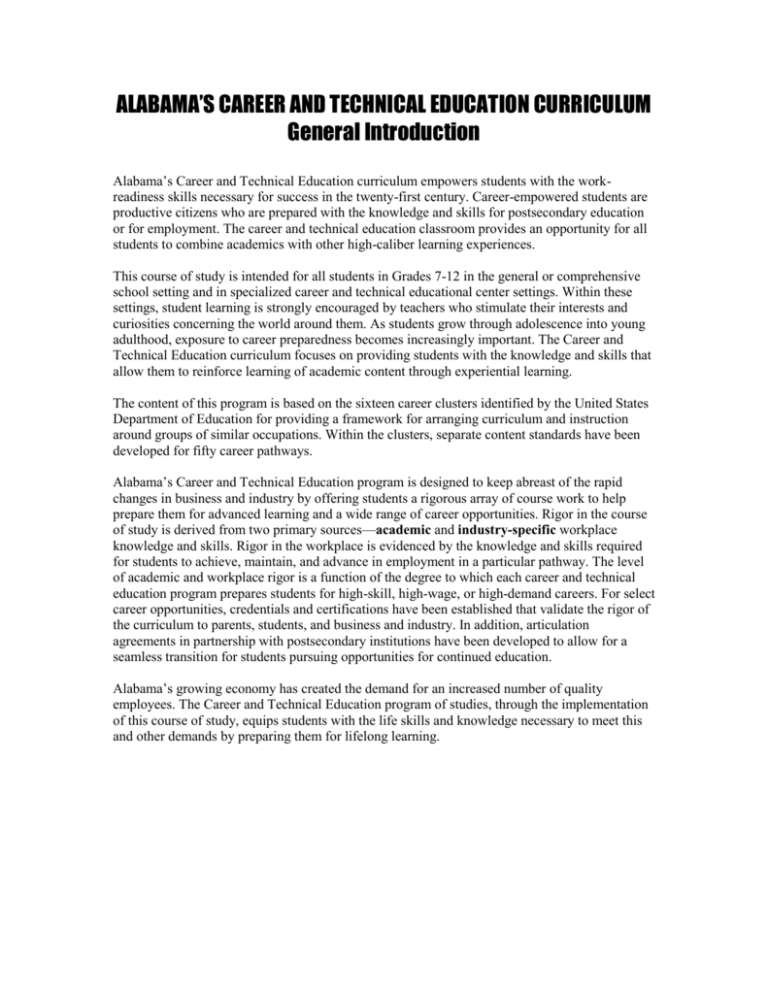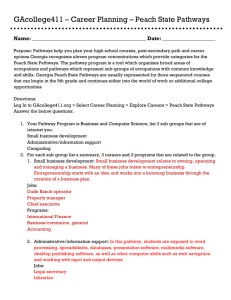ALABAMA'S CAREER AND TECHNICAL
advertisement

ALABAMA’S CAREER AND TECHNICAL EDUCATION CURRICULUM General Introduction Alabama’s Career and Technical Education curriculum empowers students with the workreadiness skills necessary for success in the twenty-first century. Career-empowered students are productive citizens who are prepared with the knowledge and skills for postsecondary education or for employment. The career and technical education classroom provides an opportunity for all students to combine academics with other high-caliber learning experiences. This course of study is intended for all students in Grades 7-12 in the general or comprehensive school setting and in specialized career and technical educational center settings. Within these settings, student learning is strongly encouraged by teachers who stimulate their interests and curiosities concerning the world around them. As students grow through adolescence into young adulthood, exposure to career preparedness becomes increasingly important. The Career and Technical Education curriculum focuses on providing students with the knowledge and skills that allow them to reinforce learning of academic content through experiential learning. The content of this program is based on the sixteen career clusters identified by the United States Department of Education for providing a framework for arranging curriculum and instruction around groups of similar occupations. Within the clusters, separate content standards have been developed for fifty career pathways. Alabama’s Career and Technical Education program is designed to keep abreast of the rapid changes in business and industry by offering students a rigorous array of course work to help prepare them for advanced learning and a wide range of career opportunities. Rigor in the course of study is derived from two primary sources—academic and industry-specific workplace knowledge and skills. Rigor in the workplace is evidenced by the knowledge and skills required for students to achieve, maintain, and advance in employment in a particular pathway. The level of academic and workplace rigor is a function of the degree to which each career and technical education program prepares students for high-skill, high-wage, or high-demand careers. For select career opportunities, credentials and certifications have been established that validate the rigor of the curriculum to parents, students, and business and industry. In addition, articulation agreements in partnership with postsecondary institutions have been developed to allow for a seamless transition for students pursuing opportunities for continued education. Alabama’s growing economy has created the demand for an increased number of quality employees. The Career and Technical Education program of studies, through the implementation of this course of study, equips students with the life skills and knowledge necessary to meet this and other demands by preparing them for lifelong learning. ALABAMA’S CAREER AND TECHNICAL EDUCATION CURRICULUM Conceptual Framework Alabama’s Career and Technical Education program is designed to empower students to meet the daily challenges of the twenty-first century with the work-readiness skills needed for success. This program provides a curriculum wherein students are actively engaged in learning through career-oriented activities. A graphic representation of the program is shown on the conceptual framework graphic located on page 3 of this document. The framework, represented by a wheel with a hub in the center of the diagram, spokes that extend from the center outward, and three outer rings, depicts in broad terms the sequence of student learning opportunities for pursuing individual career objectives within the Career and Technical Education program. The goal, Career Empowerment Through Knowledge and Skills, is common to all the clusters as represented by its prominent position on the hub of the wheel. The sixteen national career clusters, each of which contains a foundation course embedded with the essential knowledge and skills common to all career and technical education programs, encircle and form the outer rim of the hub. The fifty supported national career pathways are represented on the spokes of the wheel that radiate from the hub to the outer rings. These national career pathways supply a sequence of courses designed to provide students strong backgrounds in specific careers leading to workbased learning, four-year college and university programs, and other postsecondary programs as indicated on the three outer rings of the wheel. The Career and Technical Education curriculum, together with postsecondary and four-year college and university programs, empowers students to become competitive employees and productive citizens. CAREER CLUSTERS, PATHWAYS, AND COURSE WORK Alabama’s Career and Technical Education program is representative of the national career and technical education model. The national model includes sixteen career clusters. Career clusters in Alabama’s curriculum include courses that identify academic and technical knowledge and skills needed for students to pursue a wide range of career opportunities. Courses provide rigor and relevance for students by linking school-based learning with career-related experiences. Career clusters provide the framework for what students need to know and be able to do for success in the twenty-first century. The sixteen clusters included are: • Agriculture, Food, and Natural Resources • Architecture and Construction • Arts, Audio-Video Technology, and Communications • Business, Management, and Administration • Education and Training • Finance • Government and Public Administration • Health Science • Hospitality and Tourism • Human Services • Information Technology • Law, Public Safety, Corrections, and Security • Manufacturing • Marketing, Sales, and Service • Science, Technology, Engineering, and Mathematics • Transportation, Distribution, and Logistics The following pages contain both a narrative and a chart for each of the sixteen career clusters contained in this document. Each narrative provides an overall description of the cluster. The chart that follows the narrative includes the name of the cluster, information regarding optional and foundation courses, pathways for the cluster, a list of all courses included in each cluster pathway, other related pathways, and cluster elective courses. Cluster names are located at the bottom of each chart.* Optional courses for students who are beginning their orientation to career and technical education in middle school are listed immediately above the cluster name. These courses provide students with an overview of the clusters and pathways. Immediately above the optional courses are the foundation courses. Each of the sixteen clusters is composed of one or more pathways that students may pursue within a cluster. Pathway names are found above the middle and junior high school courses in the charts. Listed within each column for the pathways are the courses that students may study in that pathway to achieve mastery in an industry sector. Three hundred courses have been developed to satisfy the pathways contained in this document. At the top of the chart are other related pathways and cluster electives. These are also grouped by pathways. All career and technical education courses, including the required content for each course, are found on the pages following the career cluster narratives and charts. Courses in this document are listed in alphabetical order rather than grouped by pathway to avoid repetition of courses. In the Human Services cluster, students choose one of seven pathways―Consumer Services; Food, Wellness, and Dietetics; Interior Design; Fashion; Personal Care Services; Early Childhood Development and Services; or Family Studies and Community Services. One foundation course, ten related pathway courses, and twelve specialized pathway courses are offered in this cluster. Credentialing opportunities and articulation of courses with postsecondary institutions help provide the basis for identifying courses and course content for each pathway. Each course contains specific content standards indicating what students should know and be able to do upon completion of each course. Teen Discoveries and Teen Connections are middle school courses offered to students in Grades 7 and 8. These courses incorporate knowledge and skills related to the Human Services cluster. Family and Consumer Sciences is the foundation course for these pathways, except for the Personal Care Services pathway. The Personal Care Services pathway includes the career fields of cosmetology and tailoring. The required foundation course for cosmetology is Introduction to Cosmetology, and the required foundation course for tailoring is Tailoring Basics. Students are encouraged to take a foundation course before entering a pathway. Students interested in this cluster should be able to comprehend course materials and complete laboratory work, projects, and assignments related to the Human Services cluster. Students obtain knowledge about family studies and consumer services from challenging curricula, acquire technological expertise required in the field, and participate in daily tasks and skills mandatory for human service professionals. The Human Services cluster classroom and required laboratories provide safe and innovative settings for student exploration and mastery of required course content. Career and technical student organizations are integral, cocurricular components of each career and technical education course. These organizations serve as a means to enhance classroom instruction while helping students develop leadership abilities, expand workplacereadiness skills, and broaden opportunities for personal and professional growth.







